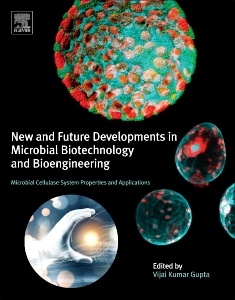Description
New and Future Developments in Microbial Biotechnology and Bioengineering
Microbial Cellulase System Properties and Applications
Language: English
Subjects for New and Future Developments in Microbial Biotechnology...:
Keywords
active site; agricultural; alkaline; applications; Aspergillus; auxiliary enzymes; bacteria; bacterial cellulose; bioabsorbable bacterial cellulose; bioactive compounds; bioconversion; biofuels; biomass; biopolishing; biopulping; bioscouring; biostonewashing; blend wall; brewery; cationic surfactant; CBMs; CelC2; cell wall; cellulase; cellulase enzyme; cellulase enzyme system; cellulase mechanisms; cellulase synergism; cellulases; cellulolytic bacteria; cellulolytic fungi; cellulose; cellulose binding domain; cellulosic biofuels; cellulosic biomass; cellulosome; clarification; cloning and expression; Clostridium cellulovorans; covalent binding; reusability; deinking; drainage; dynamic model; endo-glucanase; endocellulases; endoglucanases; enzymatic hydrolysis; enzyme cocktail; enzyme production race; enzymes; ethanol; extraction; fertilizers; fiber analysis; food industry; fungal cellulase; GH families; grass; hemicellulase; high-value products; hydrolysis modeling; immobilization; industrial applications; industry; kinetics; legumes; lignocellulose; lignocellulosic biofuel; macroalgae; marine; medical; micellization; microalgae; microorganisms; monotonicity; nanomaterial; network; oat hulls; oil palm; paper recycling; pigments; plant cell wall; production rate; reactors; Rhizobium; simulation; stability; supporting materials; synergistic effect; techniques; thermostable; Trichoderma; veterinary; waste management; weed plant; wine industry
Support: Print on demand
Description
/li>Contents
/li>Readership
/li>Biography
/li>Comment
/li>
New and Future Developments in Microbial Biotechnology and Bioengineering: Microbial Cellulase System Properties and Applications covers the biochemistry of cellulase system, its mechanisms of action, and its industrial applications. Research has shed new light on the mechanisms of microbial cellulase production and has led to the development of technologies for production and applications of cellulose degrading enzymes.
The biological aspects of processing of cellulosic biomass have become the crux of future research involving cellulases and cellulolytic microorganisms, as they are being commercially produced by several industries globally and are widely being used in food, animal feed, fermentation, agriculture, pulp and paper, and textile applications. The book discusses modern biotechnology tools, especially in the area of microbial genetics, novel enzymes, and new enzyme and the applications in various industries.
As a professional reference, this new book is useful to all researchers working with microbial cellulase system, both academic institutions and industry-based research bodies, as well as to teachers, graduate, and postgraduate students with information on continuous developments in microbial cellulase system. The book provides an indispensable reference source for chemists, biochemical engineers/bioengineers, biochemists, biotechnologists and researchers who want to know about the unique properties of this microbe and explore its future applications.
Part I: Cellulose Systems
Chapter 1: Important Roles of the Cellulosome on Degradation of Plant Biomass
Chapter 2: Fungal Cellulases: An Overview
Chapter 3: Comparative Biochemistry and Kinetics of Microbial Cellulase
Chapter 4: Impact of Microbial Cellulases on Microbial Cellulose Biotechnology
Part II: Diversity
Chapter 5: Microbial Diversity and Cellulase Production
Chapter 6: Diversity of Microbial Cellulase System
Chapter 7: Enzymatic Hydrolysis of Cellulose for Ethanol Production: Fundamentals, Optimal Enzyme Ratio, and Hydrolysis Modeling
Part III: Methods and Advancements
Chapter 8: Rhizobium Symbiotic Enzyme Cellulase CelC2: Properties and Applications
Chapter 9: Thermostable and Alkaline Cellulases from Marine Sources
Chapter 10: Cloning and Recombinant Expression of a Cellulase
Chapter 11: Recent Updates on Immobilization of Microbial Cellulase
Chapter 12: Molecular Characterization of Nanoimmobilized Cellulase in Facilitating Pretreatment of Lignocellulosic Biomass
Part IV: Applications
Chapter 13: Cellulase in Pulp and Paper Industry
Chapter 14: An Overview of Cellulose-Degrading Enzymes and Their Applications in Textile Industry
Chapter 15: Applications of Cellulase in Biofuel Industry
Chapter 16: Cellulase Application in Enzymatic Hydrolysis of Biomass
Chapter 17: Cellulases: Application in Wine and Brewery Industry
Chapter 18: Cellulases for Food Applications
Chapter 19: Cellulase Applications in Pigment and Bioactive Compound Extraction
Chapter 20: Identifying Potential Cationic Surfactant – Cellulase and Computational Approaches
Chapter 21: Cellulase in Waste Management Applications
Chapter 22: Microbial Cellulase Applications in Algal Research
Chapter 23: Cellulase in Biomedical Research
Bioengineers, Biochemical Engineers, Biochemist, Biotechnologists
Dr. Gupta is the editor-in-chief of the International Journal of Plant Pathology and a regional editorial board member of 8 other respected journals. He is the author of 40 journal articles and 27 book chapters. Gupta has also written and edited books and series from reputed publishers, including CRC Press, Taylor and Francis, USA; Springer, USA; Elsevier, USA; Nova Science Publisher, USA and LAP Lambert Academic Publishing, Germany.
- Compiles the latest developments made and currently undergoing in the area of microbial cellulase system
- Chapters are contributed from top researchers on this area around the globe
- Includes information related to almost all areas of microbial cellulase system
- Extensive cover of current industrial applications and discusses potential future applications




